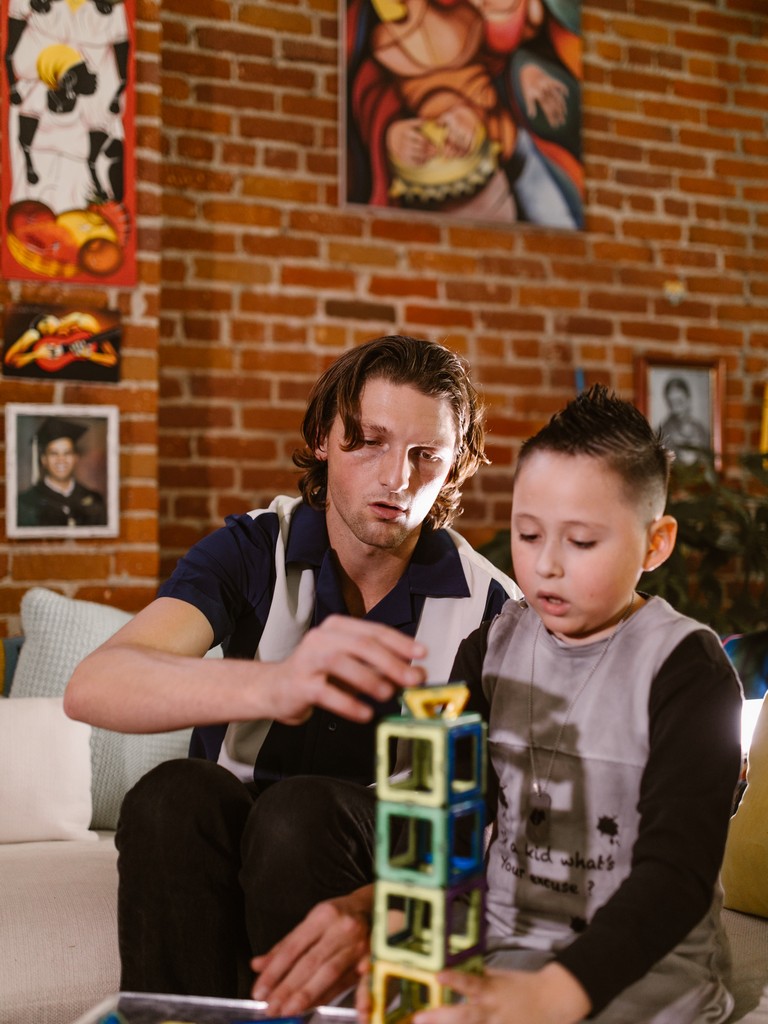Montessori Education at Home: Tips and Activities for Homeschooling Parents
Montessori education is a child-centered approach that emphasizes independence, self-directed learning, and hands-on activities. If you are a homeschooling parent looking to incorporate Montessori principles into your home, here are some tips and activities to get you started:
1. Create a prepared environment:
Set up a designated area in your home for your child’s learning activities. Include child-sized furniture, shelves, and baskets or trays for organizing materials.
2. Encourage independence:
Provide your child with opportunities to do things on their own, such as dressing themselves, preparing snacks, and cleaning up after themselves.
3. Follow your child’s interests:
Allow your child to choose activities that interest them and follow their lead. This helps to foster a love of learning and encourages self-motivation.
4. Incorporate practical life skills:
Montessori education emphasizes the importance of practical life skills, such as cooking, cleaning, and gardening. Involve your child in these activities and encourage them to take responsibility for their self-care.
5. Use hands-on materials:
Montessori education uses a lot of hands-on materials to help children learn abstract concepts. These materials are designed to be self-correcting and promote independent learning. Some examples of Montessori materials include the knobbed cylinders, the pink tower, and the sandpaper letters. You can purchase these materials or make your own using everyday objects.
6. Focus on sensory exploration:
Montessori education emphasizes the importance of sensory exploration. Encourage your child to touch, smell, taste, and listen to their surroundings. Use materials such as sand, water, and playdough to promote sensory exploration.
7. Use real-world experiences:
Montessori education emphasizes the importance of real-world experiences. Take your child on nature walks, visit local museums, and involve them in everyday activities such as grocery shopping or meal preparation.
8. Encourage reflection:
After an activity or lesson, encourage your child to reflect on what they learned and how they can apply it in their daily life.
Montessori Education for Elementary School: What to Expect
Montessori education for elementary school builds on the foundation of the early childhood Montessori program. Here’s what you can expect:
1. Multi-age classrooms:
Elementary Montessori classrooms typically have children aged 6-9 in one classroom and 9-12 in another. This allows children to learn from and help each other and promotes a sense of community and cooperation.
2. Student-led learning:
Montessori education emphasizes student-led learning, where children are encouraged to set their own goals and work at their own pace. Teachers act as guides, observing and offering assistance when needed.
3. Integrated curriculum:
Montessori education integrates subjects, so children learn through hands-on experiences that connect all areas of their learning. For example, a science lesson may involve reading about a topic, doing experiments, and writing a report.
4. Emphasis on independence:
Montessori education for elementary school continues to emphasize independence and self-direction. Children are encouraged to take responsibility for their learning, including planning their work and managing their time.
5. Hands-on learning materials:
Just like in the early childhood Montessori program, elementary Montessori classrooms use hands-on learning materials to help children learn abstract concepts. These materials are designed to be self-correcting and promote independent learning. Some examples of elementary Montessori materials include the bead frame, the stamp game, and the grammar symbols.
6. Focus on real-world experiences:
Montessori education for elementary school continues to emphasize the importance of real-world experiences. Children are encouraged to take part in community service projects, field trips, and other activities that connect them with their world.
7. Emphasis on social-emotional learning:
Montessori education for elementary school places a strong emphasis on social-emotional learning, helping children develop empathy, communication skills, and conflict resolution skills.
8. Self-assessment and reflection:
Children are encouraged to assess their work and reflect on their learning, setting goals for themselves and taking responsibility for their progress.
The Controversy Surrounding Montessori Education: What You Need to Know
Montessori education has been a topic of controversy for many years, with some people praising it for its child-centered approach, and others criticizing it for being too unstructured or not academic enough. Here are some of the key points to consider:
1. Lack of standardized testing: Montessori education focuses on individualized learning and may not emphasize standardized testing. Critics argue that this can lead to a lack of accountability and make it difficult to measure student progress.
2. Limited teacher-directed instruction: Montessori education emphasizes student-led learning, which means teachers may not always provide direct instruction or lead group activities. Critics argue that this can lead to a lack of structure and may not adequately prepare children for traditional academic environments.
3. Cost: Montessori education can be more expensive than traditional public schools, making it less accessible to families who cannot afford it.
4. Limited research: While there is some research supporting the effectiveness of Montessori education, there is limited empirical evidence to support its benefits over traditional educational approaches.
Understanding the Montessori Education Philosophy: A Complete Guide
Montessori education is a unique philosophy of education that emphasizes the development of the whole child, focusing on their physical, emotional, social, and cognitive growth. Here is a complete guide to understanding the Montessori education philosophy:
1. Child-Centered: The Montessori education philosophy is child-centered, which means that the focus is on the individual child and their unique needs, interests, and strengths.
2. Prepared Environment: Montessori classrooms are designed to be a prepared environment, meaning that the classroom is intentionally set up to allow children to learn at their own pace, in their way, and with the materials that they choose.
3. Hands-On Learning: Montessori education emphasizes hands-on learning, where children learn through exploring and manipulating materials. These materials are designed to be self-correcting, which means that children can learn from their own mistakes.
4. Multi-Age Classrooms: Montessori classrooms are often multi-age, with children of different ages working together. This allows younger children to learn from older children and older children to develop leadership.
Montessori Education in Action: A Day in the Life of a Montessori Student
A day in the life of a Montessori student is quite different from a traditional classroom setting. Here is an example of what a typical day might look like:
8:30-9:00 am: Arrival and Greeting
Students arrive and are greeted by their teacher and classmates. They are encouraged to take off their coats and shoes and hang them up, fostering independence and responsibility.
9:00-10:30 am: Work Time
During work time, students are free to choose activities and work at their own pace. They may work independently or collaborate with others. The teacher observes and guides as needed, but does not interrupt the student’s work.
10:30-11:00 am: Snack Time
Students gather together for a snack, often brought from home. They learn to serve themselves and practice social skills like conversation and sharing.
11:00-12:00 pm: Outdoor Time and Physical Activity
Students go outside to play and engage in physical activity. This time is important for promoting gross motor skills and social interaction.
Montessori Education vs. Traditional Education: Which One is Right for Your Child?
Choosing between Montessori education and traditional education can be a difficult decision for parents. Here are some key differences between the two approaches to help you decide which one is right for your child:
1. Approach to Learning
Montessori education emphasizes hands-on learning, individualized instruction, and self-paced learning. Traditional education often relies on lectures, textbooks, and standardized testing.
2. Classroom Environment
Montessori classrooms are designed to be calm and peaceful, with children encouraged to work independently or in small groups. Traditional classrooms may be more structured, with desks in rows and a teacher at the front of the room.
3. Curriculum
Montessori education focuses on practical life skills, language development, math, and cultural studies. Traditional education covers a wider range of subjects, including science, social studies, and the arts.
4. Teacher Role
In Montessori education, the teacher acts as a facilitator, guiding students and allowing them to learn at their own pace. In traditional education, the teacher is often the central figure in the classroom, delivering lectures and providing direction.
The Benefits of Montessori Education for Toddlers: What You Need to Know
Montessori education can provide many benefits for toddlers. Here are some of the key advantages:
1. Development of Independence: Montessori education encourages toddlers to take responsibility for their learning and development. They are given opportunities to make choices and learn at their own pace, which can help develop independence and self-confidence.
2. Hands-On Learning: Montessori education emphasizes hands-on learning, where toddlers can use their senses to explore and learn about the world around them. This can help develop cognitive and motor skills.
3. Individualized Instruction: Montessori education is tailored to the needs of each child, with teachers observing and guiding each toddler based on their unique needs and interests.
4. Emphasis on Social Skills: Montessori classrooms are designed to encourage social interaction and cooperation, with toddlers working together in small groups and learning important social skills like sharing and communication.
5. Language Development: Montessori education places a strong emphasis on language development, with toddlers encouraged to develop their vocabulary and communication skills through storytelling, songs, and other activities.

Meet Helen, a passionate educator and Montessori expert with over 15 years of experience in the field. She holds a Bachelor’s degree in Education and a Master’s degree in Montessori Education. Helen’s love for the Montessori method began when she was introduced to it during her own childhood education. Since then, she has dedicated her career to promoting the Montessori approach as a way to help children develop their full potential. Through her work as a teacher, consultant, and writer, Helen has helped countless parents and educators understand and implement the Montessori philosophy in their own lives. Her articles and books have been published in various education journals and she has been invited to speak at conferences around the world. Helen believes that every child has the potential to thrive and that Montessori education provides the tools to make that happen.

2 thoughts on “Montessori Education at Home: Tips for Homeschooling Parents”